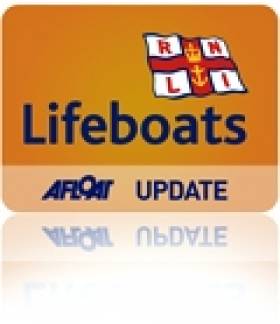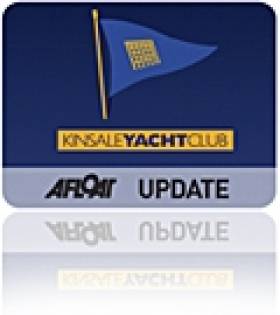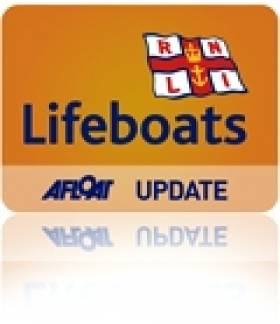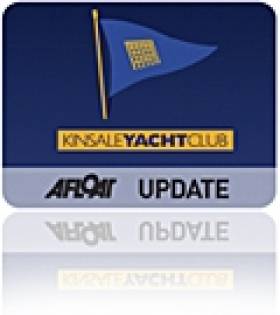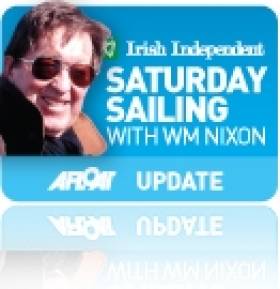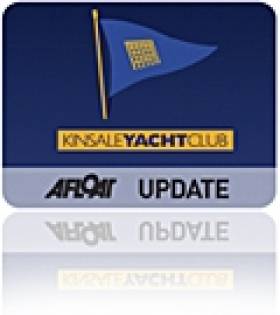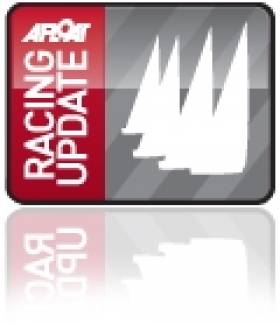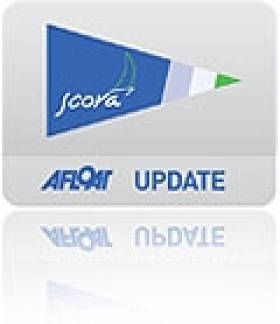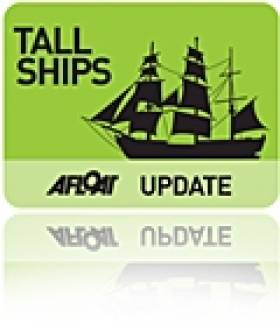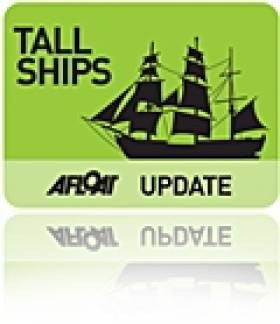Displaying items by tag: Kinsale
Rescued Sailors Join Kinsale RNLI Mayday Campaign
#RNLI - Crew members from the training ship Astrid that sank on 24 July 2013 visited Kinsale RNLI lifeboat station to thank volunteer crew and support the RNLI’s Mayday campaign.
Some 30 young people were brought to safety by RNLI lifeboat Miss Sally Anne Baggy when the tall ship hit rocks between Oysterhaven and Kinsale.
Volunteer crew members Liam O’Connell, Nick Searls and Jim Grennan, who were on the Kinsale RNLI lifeboat on the day Astrid sank, were on hand to welcome the visitors and present them with iconic Yellow Welly key rings to mark the occasion.
Undeterred by their experience last summer, the youngsters were taking part on a training exercise on 70ft schooner Spirit of Oysterhaven, the flagship of The Oysterhaven Centre.
The Astrid rescue was just one of more than 40 rescue missions launched by Kinsale RNLI last year.
Voice of Ireland judge and former Westlife member Kian Egan has lent his support to the Mayday campaign which runs from this Thursday 1 till Monday 5 May, when the charity’s volunteers will be selling yellow welly pin badges and key rings for a €2 donation, in cities, towns and villages throughout Ireland.
And as previously reported on Afloat.ie, there will also be a number of welly-themed events held to raise funds for the lifesaving charity in Ireland.
Wild Ride at Kinsale as Cruiser–Racers Take on 34–Knot Winds
#kinsale – Kinsale's magnificent harbour provided the protection required to get the penultimate day of the MMD Spring Series underway as winds reached gale force along the souith coast. It proved to be the wildest day so far with several dramatic broaches on the race course. Fortunately all returned to shore safely with nothing more serious than a few ripped sails. The Committee boat remained inside the harbour for some shelter which was a wise decision as some competitors recorded gusts of 34 knots.
Meridian (Tom & Ursula Roche ) is holding the lead in Class 0 Echo with Freya (Conor Doyle) taking the honours in IRC, Godot (Godkin & O'Donovan) currently lies second in both classes.
Fool's Gold ( Rob McConnell) has an outstanding result in Class 1 IRC with an unbeatable full stack of bullets, Justus ( Dan Buckley) is holding second place. Fool's Gold has also managed to be placed second overall in Class 1 Echo with KYC's Joker (Broderick & Gibbons ) leading by 2 points.
Results in Class 2 Echo and IRC are almost identical with Bad Company (Desmond, Ivers & Deasy ) leading in both followed by The Main Four (Salter & O'Regan)
Class 3 Echo is being hotly contested with Chameleon (Padraig O'Donovan), Gunsmoke (Sammy Cohen) and Powder Monkey (Liam Lynch) all tying on 13 points ! Chameleon is clinging to the lead with the best combination of placings. Bandit (Marron & O'Connell) still leads Class 2 IRC with another good day on the racecourse despite a spectacular broach.
Once again results are mirrored in both IRC & Echo in Class 4 with KYC's Sundancer (Alan Mulcahy) proving to be unbeatable. RCYC's Thistle (Peter Webster) lies second in both Classes.
The sponsor of today's prizes was Cheeky Cherubs Childcare, with the proprietor Michelle Akerlind presenting the prizes.
The Spring Series finishes on Saturday 26th with a prize giving dinner after racing in the Club House of Kinsale Yacht Club. Full results here
More Honours For Kinsale Lifeboat Crew Over 'Astrid' Rescue
#RNLI - Last Friday (11 April) was a busy night for the volunteer crew of Kinsale RNLI as they collected two West Cork community awards for bringing to safety the 30 crew members of the training ship Astrid that sank outside Kinsale harbour in July last year.
The first honour of the night was bestowed at the 25th anniversary awards ceremony in Bandon’s Munster Arms Hotel, organised by The Opinion magazine and sponsored by Bandon Co-op.
Kinsale lifeboat Miss Sally Anne (Baggy) was first on the scene on 24 July 2013 when the Astrid ran aground. Volunteer crew members Liam O’Connell, Nick Searls and James Grennan worked in treacherous conditions to safely evacuate all 30 crew on board.
They accepted The Opinion/Bandon Co-op Community Award on behalf on the RNLI, along with volunteers from Courtmacsherry RNLI who assisted the rescue.
Next stop was Acton's Hotel for the Kinsale District and Community Awards. Flanked by boat and shore crew and volunteers from the fundraising team, Liam, Nick and James accepted their second trophy of the night.
Lifeboat operations manager John O’Gorman said: “This is a great honour for all the volunteers of the RNLI who give freely of their time to save lives at sea. As volunteers, our only reward is the satisfaction of a job well done and the respect of our community. We have received that in abundance tonight."
This brings to three the number of awards related to the Astrid. Earlier this year the Irish Cruising Club presented Kinsale RNLI with the Waterford Cup, a perpetual trophy dating back to 1953.
Kinsale Yacht Club Launches 2014 Sailing Season in Style
#kyc – Kinsale Yacht Club got the 2014 sailing season off to a dramatic start today for the first two races of its MMD Construction sponsored Spring Series for cruisers. It was John Godkin's Dufour 44 Godot that took advantage of the big seas and gusty south westerly winds to lead in IRC after two races in Class zero from Tom Roche's Salona 45, Meridian in a four–boat fleet writes Claire Bateman.
In a five boat fleet Dan Buckley's J109 Justus has the lead in IRC one from Diarmuid and Hilda Good's Exhale, an X362 Sport .
In Class One Rob McConnell's Fool's Gold leads in ECHO and is on equal points with the Broderick and Gibbons Joker
The 2014 Sailing Club of the Year Award winner has organised racing for four separate classes in the April series with today's racing sponsored by Des McWilliam of UK Sails. Class three has the marginally biggest fleet with six starters. Flyover, the well campaigned Sigma 33 ood skippered by David Marchant from Waterford holds the early lead in class three from Bandit, the modified Bolero of Kieran O'Connell and Graham Marron.
A mild day and a 15 to 20 knot breeze provided the spinnaker fleets with great racing with two races on windward/leeward courses and organised in such a way that classes Zero, One and Two sailed longer courses but were able to finish at approximately the same time as Classes Three and Four thus enabling the second race to get under way promptly. The White Sail fleet which started in off Charlelsfort blew away the cobwebs after the long winter recess. The fleet totalled thirty one boats, ten of which came from the Royal Cork Yacht Club, and three from Waterford Harbour Sailing Club.
Racing will continue next Sunday with FG 11.55a.m. for spinnaker fleets and 12.55 p.m for White Sail.
Full results by class here. More photos below.
Irish Cruising – Sailing's Magic Elixir for a Long Life
#cruising – Cruising is the hidden side of sailing, yet it's the choice for the majority of those going afloat. Whether it's day cruising, a longer venture in the annual holidays, or the dream cruise of a lifetime across oceans, this is our sport. Unlike racing, which generates its own narrative even if only through the recorded results, much of cruising would slip under the radar completely were it not for cruising awards. W M Nixon considers the latest annual batch from the Irish Cruising Club.
Cruising under sail seems to be the secret of eternal youth. Last night's Annual General Meeting of the Irish Cruising Club in Dun Laoghaire saw a distribution of awards to voyagers from all parts of Ireland who sailed successfully in many areas of the globe in boats mostly of modest size. Yet any outside analyst would soon have made the point that many of the achievers were of mature – sometimes very mature - years, and fulfilling a retirement dream.
But despite any ICC membership gathering these days being a sea of silver heads, age is the last thing they think about. This club of 550 members has become the mixture of an Active Retirement Association – very active indeed, as it happens – and a sort of seagoing extension of the Men's Shed movement.
If you were looking for an illustration of Ireland's changing demographics, and our very rapidly changing attitude as to what constitutes old age, you need look no further than the ICC. Time was when it was thought quite something when one of the club achieved the Golden Jubilee of their membership. But these days, it's no big deal to have been on the strength for fifty years, as the senior member is Joe FitzGerald of Crosshaven, who this year marks 70 years in the club, and he is closely followed by Douglas Mellon who joined in 1947 from Howth - he now lives on the Scottish Riviera in Kircudbright.
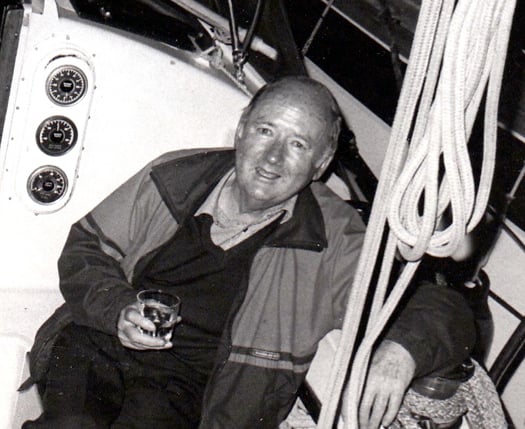
Joe FitzGerald of Cork is the ICC's most senior member, having joined in 1944. He served as Commodore from 1984 to 1987.
All those years ago when they took up their membership, it was thought perfectly normal for young men – married or otherwise - to take off for at least a fortnight's cruising every year, regardless of family demands which these days would be regarded as the prior commitment. In fact, nowadays so much emphasis is placed on family life and families doing just about every last recreational thing together, that younger married sailing people either do extremely short-hop cruising of the type necessitated by catering for the needs of all the members of the family, or else they don't cruise at all in the traditional sense - "Fun For All The Family" effectively rules out proper cruising.
Then too, modern life has so many other distractions - not least of them work demands which involve 24/7 attention - that the old-style easygoing simply-wandering-along holiday cruising is very much a minority activity. This means that at first it seems young people are not taking up traditional cruising at all. But with its deep experience garnered since its foundation in 1929, the Irish Cruising Club has learned to take the long view. It is not unduly concerned by the steadily rising age profile of its membership, and certainly every year there is a significant group of sometimes quite senior yet nevertheless increasingly active cruising enthusiasts joining the club.
They're the embodiment of the slogan that Sailing is a Sport for Life, and it's only politeness which prevents them saying that the subtle pleasures of cruising are wasted on the young. So when you look at the lineup of achievement represented by last night's awards, it's natural to wonder what these people did in earlier life, that they can nowadays afford the time, resources and dedication necessary to complete voyages of this quality.
The adjudication was done by Dave Whitehead of Kinvara on Galway Bay, himself no stranger to the ways of the sea while making long voyages in small craft. He breaks new ground by awarding three trophies at once to Sam Davis of Strangford Lough, whose Cape Horn and Pacific ventures with his Rival 41 Suvretta have been quietly bubbling away in the background of ICC activity for the past three years.
Sam Davis first featured in Afloat magazine in March and April 1981 when we ran his two-part account of his first ocean voyage, an Atlantic circuit from Strangford Lough between 1976 and 1979 with the 34.5ft West Solent Class Suvretta, a former racing boat he'd found in a derelict state and restored to ocean-going condition.
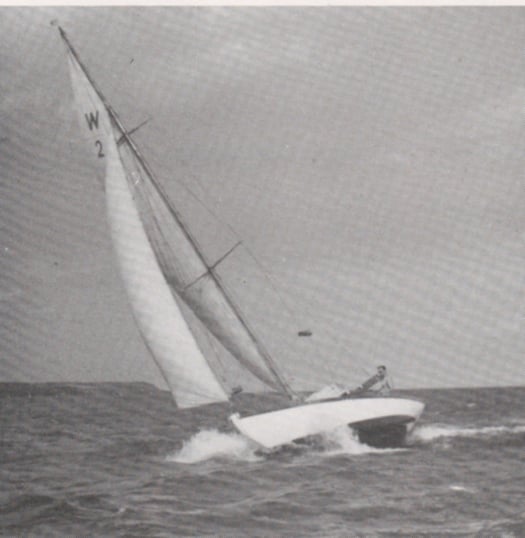
The 34ft West Solent class Suvretta in her offshore racing days in the 1950s when she was based in Belfast Lough. When Sam Davis did the Atlantic Circuit cruise with her in 1976-79, she carried a less loft mainmast, with masthead rig.
But even with Sam's improvements, she was still no more than a slip of a boat, so it says much for his grit and skill that he brought her through the Fastnet storm of 1979 as he sailed the final hundred miles back to Ireland. There was damage aloft, and he'd to get into Dunmore East unaided with jury rigging, but the job was done.
While in the Caribbean, he'd worked in charter yachts between times to make a shilling or two. But after he'd spent time back in Northern Ireland, he went abroad into serious seafaring in offshore service industries, working in places like The Gulf, the North Sea, the Amazon, the Red Sea and Malaysia, becoming a fully accredited Marine Consultant.
Yet if you ask him nowadays what he is and what he was, he'll say he's a farmer and former seaman, as his purchase some years ago of Conly Island in Strangford Lough (you can drive out to it when the tide is down) gives him the little bit of land, and an anchorage too, while "seaman" covers his many experiences in offshore work.
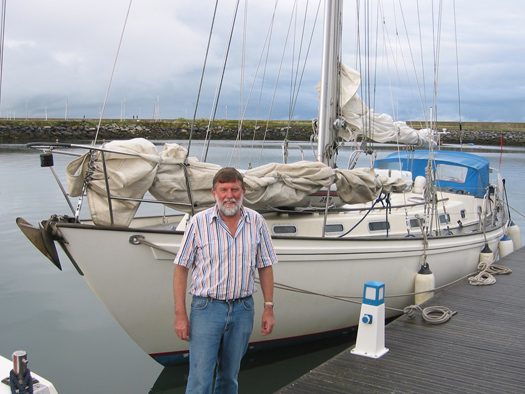
Sam Davis with his newly-acquired Rival 41, re-named Suvretta, in 2009. Photo: W M Nixon
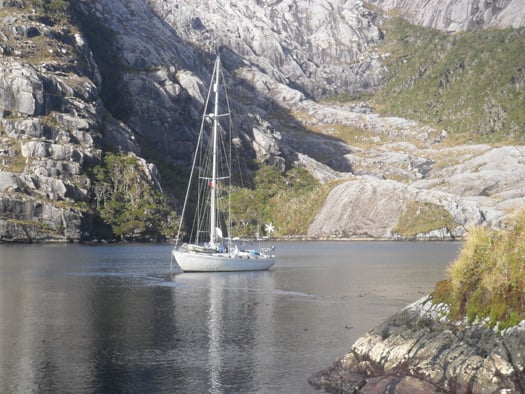
Suvretta in the Beagle Channel in southern Chile. Photo: Sam Davis
Back in 2009 he bought a Rival 41, a hefty and able vessel, a sister-ship of Waxwing in which fellow ICC members Peter and Susan Gray of Dun Laoghaire went round the world 14 years ago. Sam re-named his new boat Suvretta, spent the winter sorting her out, and in 2010 he was gone, sailing south single-handed to eventually round Cape Horn and then spend a long time on the coast of Chile. He was delayed there as a ship broke drift and damaged the boat, but it was well fixed, and he voyaged on into the Pacific to many islands, including Pitcairn and the Tahiti group.
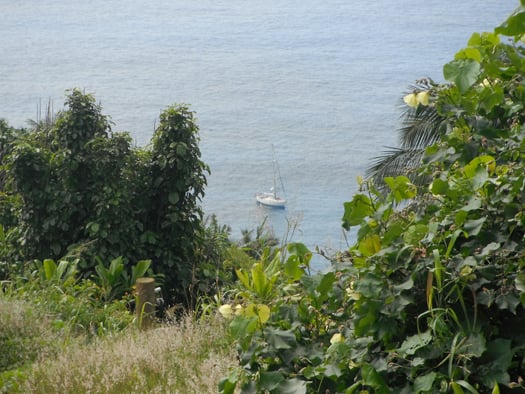
Restless anchorage. Suvretta in Bounty Bay on Pitcairn Island. Photo: Sam Davis
Eventually he fetched up for some time in Tonga, where he became enthused about the 73ft Vakas, the Pacific islanders' contemporary take on the classic Polynesian inter-island vessels (see Sailing on Saturday 11th January 2014). But by November 2012 it was time to head for home, so Suvretta sailed southeast for Cape Horn non-stop, and having rounded it, shaped her course for Port Stanley in the Falklands.
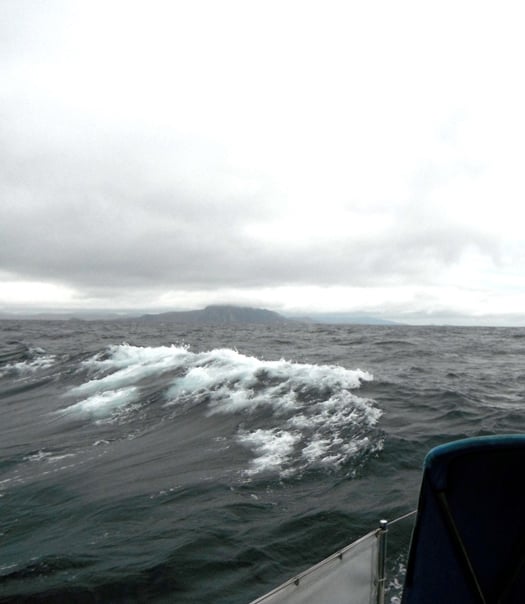
Suvretta rounding Cape Horn for the second time, 21st January 2013. It was only when the Horn was well astern that the weather deteriorated rapidly to make for a challenging approach to Port Stanley. Photo: Sam Davis
However, while rounding the Horn had been simple enough, the passage onwards to Stanley became increasingly fraught, running before rising storm force winds. Conditions were such that it looked for a while as though the lone sailor was going to be swept right past the islands, but he made the cut into shelter to such a nicety that he is awarded the ICC's Rockabill Trophy for Seamanship.
And then when Port Stanley was reached, a very fine passage had been completed from Tonga, so last night for that he was additionally awarded the ICC's Atlantic Trophy for the best voyage with a non-stop leg of more than a thousand miles. And then finally, after they'd spent the mid part of 2013 working their way up the Atlantic with the lone skipper particularly enjoying himself at ports on the Irish coast, Suvretta and Sam returned after three years to Conly Island. And they'd now done more than enough to also be awarded a third trophy - the ICC's premier honour, the Faulkner Cup.
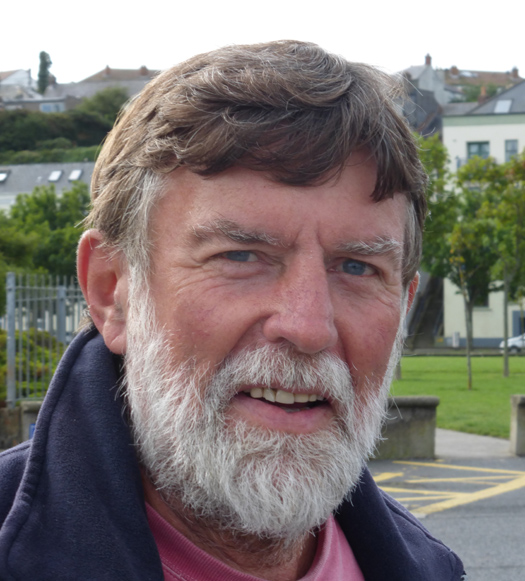
Home again. Sam Davis back in Ireland, August 2013. Photo: W M Nixon
With such a high level of activity by many members, ICC adjudicators always find some final choices to be a very close call, so some years ago the Strangford Cup was inaugurated for the cruise which almost won the Faulkner Cup. This year it has gone to a fine cruise from Portugal to Madeira and through the Azores in detail before returning to Portugal.
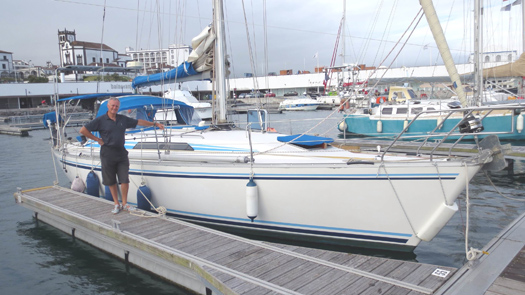
John Duggan with his MG CS40 Hecuba in Horta in the Azores
John Duggan originally hailed from Malahide where he sailed, and he also sailed with the college teams while at Trinity College in Dublin. He cruised and raced offshore mostly in the Irish Sea, but having qualified as an accountant he decided to spread his wings internationally, and he became one of those key people who turn up as partners in one of the big four accountancy firms worldwide.
Eventually his career brought him to the company's offices in Lisbon. Living in Portugal suited him fine, so he put down roots and in time bought himself an interesting cruiser. Hecuba is a 1989 Canadian-built Tony Castro-designed MG CS40, a handsome 12m craft with good performance enhanced by an effective wing keel.
During his final years in the day job he gradually improved the boat with a mind to some proper cruising once he retired at 60, something which he planned with all a high-powered accountant's meticulous attention to detail. He remembers the final day at the office, when a friend on the other side of the world sent him an email: "Even the worst day of your retirement will be better than the best day at work".
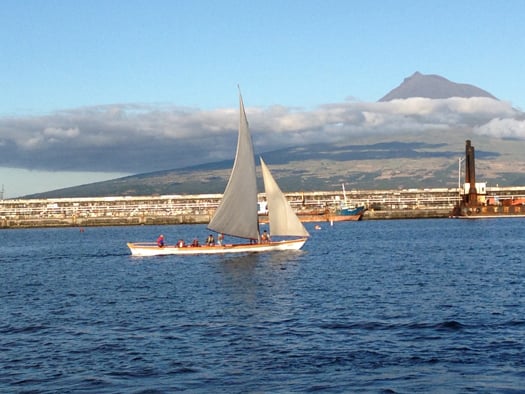
Azorean whaleboat with Pico beyond seen during one of Hecuba's cruises from Portugal to the Azores. Photo: John Duggan
Maybe so, yet not everyone makes the changeover smoothly, but in John Duggan's case the challenge of planning and executing remarkably civilised yet challenging cruises has proven to be a complete new job in itself, but much more fun than number crunching. He goes to enormous trouble to make sure that his crews have as enjoyable and varied an experience as possible, yet all the time he is quietly keeping the project moving along while noting details and features of ports visited which might be of interest to fellow skippers, a habit which is the hallmark of the true cruising man.
When you live in Cascais with your boat based in the marina nearby, the Azores are the western isles which call you each summer. But unlike Scotland's Western Isles which are just a day's sail away across the Sea of the Hebrides, the Azores involve an immediate ocean voyage from Portugal of at least 500 miles. However, for 2013's cruise west, Hecuba made it a triangle, going first to Madeira before going on nor'west to the Azores which were cruised in detail before returning to Cascais after six weeks away, having logged 2390 miles, with the final tabulation being:
Hours spent close hauled: Zero.
Cross words exchanged: Zero.
Inevitably the two big awards dominate the scoresheet, but the ICC also has a host of trophies which reflect every level of club sailing activity. The Round Ireland Cup, for instance, is for the circuit which produces most information for the club's sailing directions, and in a year in which a goodly number went round, it was Donal Walsh of Dungarvan with his Moody 31 Lady Kate who best filled the bill.
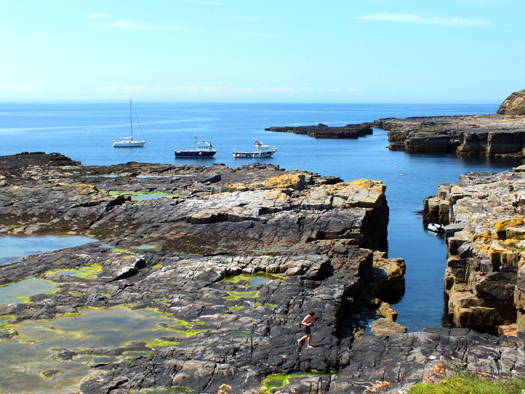
Donal Walsh's Lady Kate anchored at Inishmurray off the Sligo coast during his detailed round Ireland cruise. Photo: Donal Walsh
As the Faulkner Cup was first won in 1931 by the 28ft cutter Marie, the Marie Trophy is for the best cruise by a boat under 30ft, and Mick Delap from Valentia Island with his Tamarisk 24 gaff cutter North Star fits into the size requirement with six feet to spare. He made a fine job of completing a two-summer circuit of Ireland by returning from western Scotland via the Irish Sea and Ireland's south and southwest coasts.
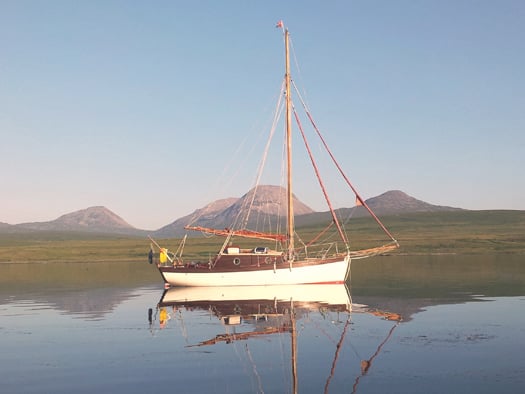
Mick Delap's Tamarisk 24 North Star from Valentia in Lowlandman's Bay in Jura in the Hebrides. Photo: Mick Delap
In all, the ICC has a dozen cruising trophies. But even so not everyone gets one in a typically busy year, so to encourage the newcomers they've the Perry Greer Trophy for first time log-writers, and it goes to Peter Mullan from the Quoile in Strangford Lough for his insightful account of a round Ireland cruise with the Jeanneau Sun Odyssey Sancerre.
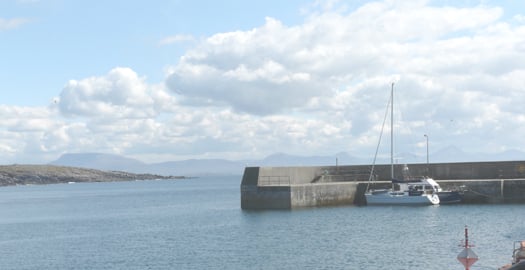
Peter Mullan's Sun Odyssey Sancerre in the little harbour at Tory Island with the Donegal highlands beyond. Photo: Peter Mullan
All the logs, including the winning ones, were featured in the ICC's 180-page Annual 2013, which Honorary Editor Ed Wheeler managed to get to the members in time for Christmas. All this is done by voluntary effort, yet the Annual would stand up to professional comparisons, as it includes informative accounts of cruises in just about every part of the world, plus a report on the ICC Cruise-in-Company to the Isles of Scilly which was an outstanding success despite coinciding with some uneven weather in June.
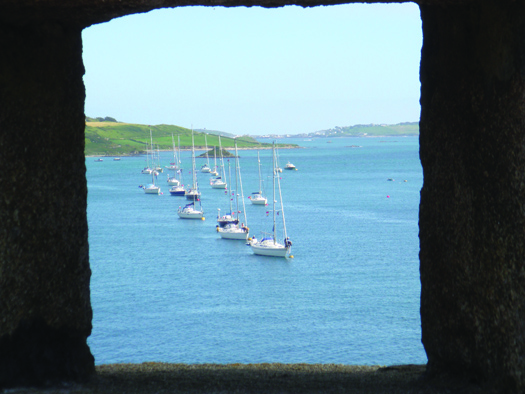
The Irish Cruising Club flotilla in the Isles of Scilly during their successful Cruise-in-Company in June 2013.
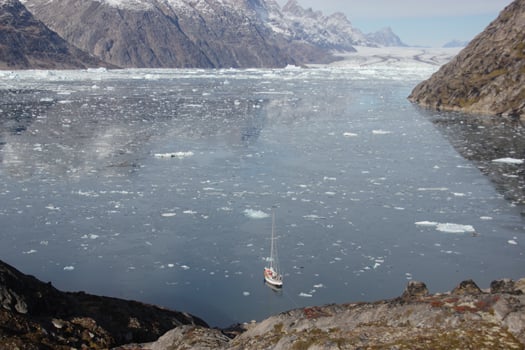
Everyone to his taste. ICC member Brian Black went to Greenland for the sixth time, crewing on Aurora. This is Kangertitiatsivaq Fjord in high summer. Photo: Brian Black
There's more to the Club than the Annual, as the ICC's programme of producing constantly up-dated Sailing Directions for the entire Irish coast in two volumes is a continuous progression, with the latest 12th Edition of the North & East Coast Book due next month from Honorary Editor Norman Kean, whose home port is Courtmacsherry.
Thus it's clear that Ireland's cruising club is a truly all-Ireland organisation, and this year it will be celebrating its 85th birthday with a Cruise-in-Company to Glengarriff where it was founded on July 13th 1929. Yet despite its obvious significance, this is a club without premises. In the final analysis, it's a club of the mind, made up of kindred spirits. Heading such a body is a mighty challenge, and the changing of the watch is always a charged moment.
Last night David Tucker of Kinsale stood down after serving his three years as Commodore, and he was succeeded by Peter Killen of Malahide. His experience in club administration is long-lived – he was Commodore of Malahide YC when it became "Club of the Year" in 1980. But it was his cruising CV which next went into overdrive, as in 1993 he voyaged north to Iceland, circled it, and then sailed back in near-record time in an S&S 30. He then moved up to a Sigma 36 which he cruised to Greenland among other places, following which he cruised even further with a Sweden 38, and then in 2004 he took on his dreamship, the Amel Maramu 54 Pure Magic.
Peter Killen seems to have cruised this very special boat just about everywhere. Not least was deep into Antarctica, where he made a memorable arrival in zero visibility with icy conditions into the natural harbour in the extinct volcanic crater on Deception Island. It was all a long way in time and distance from five boats gathered in Glengarrif in the hope of forming a little cruising organisation back in 1929. But that's the way it is with the Irish Cruising Club.
Gale Warning No Obstacle for Kinsale Dinghy Frostbite Sailing
#kinsale – For the second Sunday in a row the gales obligingly passed over to allow racing to proceed in the ASM Frostbite Series. The Race Officers reported that the winds were between 14 and 20 knots and West South West. There were no shifts and the course remained unchanged for all 3 races.
The Laser fleet proved to be a little over enthusiastic in their first race with the OD issuing a general recall. The Kinsale harbour seal came to play at the start of the second race and caused a little excitement amongst the fleet.
Sean Murphy (KYC) is the runaway leader (13pts) in the Laser Full Rig class with 7 bullets out of a possible 9. James Long (Inniscarra) lies in second on 19 points followed closely by Ian Travers (KYC) on 20 pts.
The Laser Radials returned to the race course today with Sorcha Ni Shilleabhain (KYC) taking first place with 6 pts. Sorcha has just returned from Miami and the ISAF Olympic qualifiers where she put in a magnificent performance finishing 45th overall, undoubtedly a star in the making! Cliodna O'Regan (KYC) lies in second place on 11 points and Sean Gambier Ross (KYC) follows closely with 12 points.
Billy Duane (RCYC) has powered ahead in the Laser 4.7 fleet with 8 bullets out of a possible 9 giving him a total of 7 points after discards. Ben Hunt (KYC) lies in second on 17 points and Jamie Tingle (RCYC) is third with 25 points.
The Squibs had a small fleet on the water today with only 6 boats making the start line. However this remains a hotly contested class. Allegro (Colm Dunne & Rob Gill KYC) took the honours again with 3 bullets today giving them 8 points overall. Lazurus ( Colm Daly & Marcus Hutchinson KYC) lie in second place with 15 points. KYC Commodore Finny O'Regan and his son Colm are placed third in their Squib Fagin with 23 points.
Dun Laoghaire & Kinsale Frostbite Sailing Cancelled Due to 'Orange Alert' Storm Warning
#frostbites – Thanks to weekend storms both east and south coast sailing frostbite series were cancelled yesterday. Dun Laoghaire Motor Yacht Club's Frostbite Dinghy harbour series was scrubbed and likewise on the south coast where Kinsale's renowned sheltered harbour was no match for the south westerly gale that prompted an orange alert warning from Met Eiereann and the Coast Guard.
Both series are expected to resume next Sunday.
New SCORA Commodore Appointed at Kinsale AGM
#scora – Royal Cork Yacht Club's Ronan Enright was elected Commodore of the South Coast Offshore Racing Association (SCORA) at the cruiser racing association's agm at Kinsale Yacht Club at the weekend writes Claire Bateman.
Following two years at the helm of SCORA the very popular and hard working Vinnie O'Shea RCYC stepped down as SCORA Commodore and Ronan Enright of RCYC, proposed by the outgoing Commodore and seconded by John Stallard of KY was elected This was followed by the election of the three class captains resulting as follows: Class 1 Sean Hanley RCYC, Class 2 Pat Salter KYC and Class 3 Kieran O'Connell RCYC. The new Commodore then outlined the structure of SCORA and went through the programme for 2014.
The ICRA item on promotion of crew training and how to increase participation in cruiser racing was dealt with in a very professional manner by Denis Kiely who gave what can only be described as an impassioned presentation on the subject. This was listened to with great intensity by the large attendance and responded to with views from the various clubs. The study on this item is very much ongoing and ICRA will publish more detail as they study the matter and firm up on plans.
The attendance then enjoyed a slide show presentation and complimentary finger food before the presentation of the prizes.
The meeting was very well attended with representatives from Clubs all over the south coast with strong contingents from Waterford, Schull, Cove SC, Kinsale YC and of course RCYC and it was very heartening to see the interest displayed on all sides. SCORA is alive and well and new Commodore Enright is not about to delay as he has already announced plans to get the show on the road by holding a meeting very quickly with the Class Captains to get plans moving for 2014.
Tall Ship Astrid Back From the Deep, Dutch Vessel Successfully Raised in Kinsale
#astrid – The Dutch Tall Ship Astrid that ran aground two months ago has been successfully recovered off the Cork coast today. Using specialist lifting equipment brought in from England, the 100– foot steel hull, now safely atop a massive barge, is remarkably intact as the pictures below, taken by Erskine Tanner at Kinsale harbour, show.
News of the salvage before the arrival of any autumn gales has been warmly greeted. The lift brings an end to the saga for all involved during the rescue of those on board, during her protection while she was on the rocks and in her salvage this week.
A Marine Casualty Investigation Board (MCIB) report is being prepared into the accident.
The 95-year-old vessel ran aground on to Rocks off Kinsale two months ago during a photocall for the Irish Sailing Association Gathering Cruise promotion, prompting dramatic scenes as 30 people were rescued from rough seas. The vessel has been resting on the rocks since the grounding on July 24th.
The vessel hit rocks inside the Sovereign Islands at Ballymacus Point, near Kinsale.
The training ship had lost power and was apparently driven on to rocks by a strong southerly wind at the western entrance to Kinsale Harbour. The grounded vessel quickly took on water and these pictures show where the steel hull was holed.

Salvage of Tall Ship Astrid Begins off Kinsale
#tallship – A salvage operation to remove the wreck of the Tall Ship Astrid from rocks off Kinsale is underway. The operation will involve specialist marine crane equipment brought in from the UK. The 95-year-old vessel ran aground at Rocks off Kinsale last month during a photocall for the Irish Sailing Association Gathering Cruise promotion, prompting dramatic scenes as 30 people were rescued from rough seas. The vessel has been resting on the rocks since the grounding on July 24th.
The operation is expected to take between one and two weeks, depending on weather conditions. A lifting barge and crane are due on site over the next couple of days.
Divers with the company have already completed a survey of the wreck and submitted a report to Coastguard officials on Monday.
For a month after the accident Astrid made a sad picture, still trapped on rocks, her beautiful sails torn and ripped by the sea but amazingly her rig still intact.
The vessel, which was built in 1918 and operated as a cargo ship until 1975, was on a 14-day voyage as part of an EU Youth in Action programme sailing from Southampton to Cherbourg via Kinsale. The Astrid departed Oysterhaven for Kinsale but lost power during a photocall with seven crew and 23 trainees on board.
For more on Astrid's sinking click Afloat's Tall Ship news section.


























